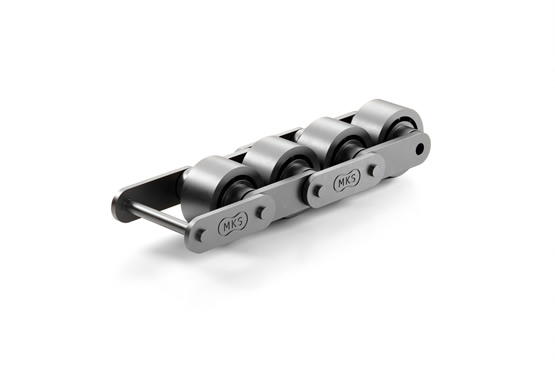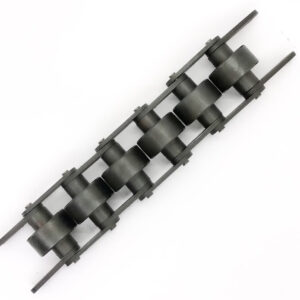


What is an Accumulation Chain?
Accumulation chain is a system that minimizes the vibrations that may occur during the placement and movement of the transported goods and thus ensures the safe positioning of the goods. This system guarantees that the loads are transported almost completely shake-free, especially when stopping and moving during transportation.
The basic principle of the accumulation chain is to prevent sudden movements and impacts between loads by evenly distributing the loads on the chain over a certain distance and maintaining this distribution. This prevents damage or irregular displacement of loads and ensures safe and undamaged transportation of products.
Accumulation chains are widely used in automation systems, assembly lines and packaging processes, increasing efficiency and safety in production and logistics processes.
What are accumulation chains for?
Accumulation chains play a critical role, especially in automated conveying and assembly lines. Here are the benefits and key functions of accumulation chains:
- Shock Absorbing Feature: Accumulation chains absorb shocks and jolts between transported products, reducing the risk of damage to products. This is especially important when transporting fragile or sensitive products.
- Managing Product Accumulation: When there is a disruption or stoppage at some point in the production line, accumulation chains allow products to accumulate and be conveyed in an orderly manner to the next processing stage. In this way, it helps to keep the flow on the line uninterrupted.
- Production Flexibility: It provides flexibility in production processes by balancing the flow of materials between production lines operating at different speeds and at different times. Delays on one production line do not affect other lines because accumulation chains can manage these temporary differences.
- Energy Saving: In areas where products accumulate, accumulation chains can stop movement when needed and save energy. This is particularly advantageous for large-scale production facilities where energy costs are significant.
- Optimizing Space Utilization: Accumulation chains enable more efficient use of available space by accumulating products in a specific area. This is a great advantage, especially for facilities with space constraints.
- Maintaining Product Quality: It contributes to maintaining product quality by preventing products from bumping into each other or being damaged during transportation and waiting processes.
- Automation and Control: Accumulation chains can be easily integrated with automated control systems, increasing the efficiency and automation level of production lines.
Overall, accumulation chains are one of the key components that ensure efficient, flexible and safe operation of modern production and distribution systems.
Accumulation chains allow workpiece carriers to be accumulated, separated, buffered, and positioned at any point throughout the workflow, and therefore conveyed independently of the process cycle. The workpiece carriers or jigs can also be bolted to the conveyor chain for synchronized transport without accumulation. They are used to convey piece goods during the accumulation-free conveyance operation. During this process, the accumulation roller chain will continue to run smoothly under the accumulated piece of goods due to freely movable conveyor rollers. Discover what is an accumulator chain and its usage areas here!
How do accumulation chains work?
A chain transport system is a method of transporting goods on a chain. The chain travels continuously, and each link of the chain is suspended by a roller. The rollers can be adjusted to allow for different speeds so that the chain is transported at different speeds depending on the product being transported. The spool-free transport operation allows pieces of cargo to sit on the chain rollers and be transported at the same speed as it moves through the machine. This allows for continuous flow without interruption or downtime during transportation (which can be costly).
During spooling, however, there is some friction between each link in the chain and its roller because of its movement through space–this friction causes a slight impact pressure on the goods being transported so that they do not slow down during this process. Accumulator chains are available in stainless steel, as maintenance-free chains as well as in duplex or triplex designs. In the case of the duplex design, the roller distance is only half that of the simplex design since the accumulation chain conveyor rollers are staggered. For long conveyance distances lateral guide plates are recommended.



What are the types of accumulation chains?
Accumulation chains vary according to their intended use and the characteristics of the material to be transported. Here are the most common types of accumulation chains:
- Roller Accumulation Chains: This type is specifically designed for transporting relatively large and flat-bottomed products such as boxes, crates or pallets. The products are transported on cylindrical rollers that are located on the chain and can rotate freely. These rollers ensure that the products move smoothly and with minimal friction.
- Pallet Accumulation Chains: Used for transportation and storage of palletized products. These chains usually include specially designed chain eyes designed to fit the gaps under the pallets. Pallets are fixed on these chains and can be transported to the desired point.
- Flat Bottom Accumulation Chains: Ideal for transporting products with flat and wide surfaces. These chains are usually made of plastic or metal plates mounted on the chain. Flat bottom chains provide stable transportation of products and are ideal for products with large surfaces.
- Flexible Accumulation Chains: These flexible chains are suitable for transporting products on twisting and complex paths. This type of chain is preferred for complex assembly lines and when product routing is required.
- Magnetic Accumulation Chains: These chains, which are used to transport materials with magnetic properties, ensure that the products are fixed on the chain with magnetic force. They are ideal for situations that require high precision or where the risk of product displacement is to be prevented.
Accumulation Chains with Sprocket and Pinion: This type is especially designed for situations where heavy loads need to be transported and positioned. The gear and pinion mechanism allows the chain to move precisely and have a high load capacity.
Usage Areas and Benefits of Accumulation Chains
You might be wondering what are accumulation chains used for. The main purpose of accumulation chains is to move goods to different locations and the industries can change vastly. They allow the load to be transported without jolting or bouncing. This makes them a great choice when heavy loads needs to be moved at a high speeds.
Accumulation chains also ensure that the transported goods will remain in place throughout their journey so that they don’t get lost or damaged during transit.
There are many benefits of accumulation roller chains.
accumulation chainsAccumulation chains are ideal for transporting products with a high weight, such as steel or concrete. They allow for the smooth transportation of products and ensure that they are transported with optimum weight distribution. The main advantage of accumulator chains is their ability to withstand high wear rates without affecting their performance or durability. Accumulators can be installed on any type of conveyor, vertical or horizontal, and they can also be used in combination with other types of conveyors such as swivel trucks, pallet trucks, and belt-driven systems.
Contact us for more information about accumulator chains. Also, you can examine the “MAKELSAN CUSTOM MADE CHAINS CATALOG” for more detailed information!
Accumulation Chains FAQ
Accumulation chain types are customizable, allowing you to customize the length of your accumulation chains and the size of your boxes. This makes them ideal for transporting items that vary in size and weight, or for transporting items that need to be stacked neatly.
Accumulator chains are suitable for the conveyance and accumulation of piece goods, and they are usually employed for a parallel-running operation. In the standard design, the chains run on a guide rail with lateral support rollers.
The following example illustrates how an accumulator chain may be used:
Accumulation Chains1. Conveyor belt transport the material to different location.
2. The material can be moved when the operation requires to do so. The materials being in the container make it an easy process.
3. The material is then transferred from this container onto a second conveyor belt which carries it back to its original starting point (where it was picked up by the first conveyor belt).
Durable accumulation chains for conveyor systems have an outer roller with a low friction coefficient, which results in energy savings of up to 30%. The length of your accumulation roller chain conveyor system can be increased by 30% without any modifications to the drive motors; or, if the system length is left unchanged, smaller drives can be fitted. It also results in a longer service life for the entire accumulator conveyor system as there is less strain on the chain and drives. In addition, since each pin takes its share of the load equally in the accumulation chains, it ensures that the products are transported smoothly and with optimum weight distribution.


